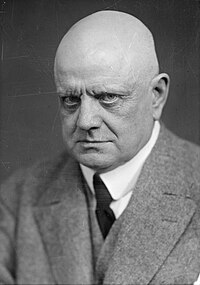|
Five Esquisses
The Five Esquisses (in Finnish: Viisi luonnosta; in German: Fünf Skizzen),[3] Op. 114, is a collection of compositions for piano written in February 1929 by the Finnish composer Jean Sibelius. The Five Esquisses represent—along with the Suite for Violin and String Orchestra in D minor (JS 185), as well as the Op. 115 and Op. 116 seven duos for violin and piano—the dawn of a "radical new stylistic period" for Sibelius. Indeed, these compositions could provide the best clues as to the "sound world" Sibelius's never-realized (and likely destroyed) Symphony No. 8 may have inhabited.[4] HistoryAn 1892 sketch of Sibelius at the piano by his future brother-in-law Eero Järnefelt The Five Esquisses have a tortuous publication history. On 5 October 1928, the New York-based publisher Carl Fischer expressing an interest in publishing "works for piano, voice and piano, and violin and piano ..."[3] Sibelius responded to Fischer on 15 February 1929 that it was his "pleasure" to offer four collections of his latest miniatures: the Op. 114 Five Esquisses, as well as the Op. 115 Four Pieces for violin and piano, the Op. 116 Three Pieces for violin and piano, and the Op. 117 (later demoted from Sibelius's opus list) Suite for Violin and String Orchestra.[5] However, Fischer rejected all four compositions:
Shortly thereafter, Sibelius sent the pieces to Leipzig's Breitkopf & Härtel, and although they accepted the offer, Sibelius requested the manuscripts be returned to him so that he could revise Metsälaulu; after making the changes, however, he never mailed them back to Germany—likely due to the ever-worsening self-criticism that marred his later career. In 1945, the Helsinki-based published R. E. Westerlund inquired about the Five Esquisses: as with fifteen years prior, Sibelius initially agreed but changed his mind when preparing the manuscripts for publication. Westerlund's second attempt in 1950 was similarly unsuccessful. In the end, the pieces were published posthumously from 1973 to 1974 by Fazer Music.[1] Structure and musicNo. 1: LandscapeLandscape (in Finnish: Maisema) is marked Andantino. No. 2: Winter SceneWinter Scene (in Finnish: Talvikuva) is marked Allegretto. No. 3: Forest LakeForest Lake (in Finnish: Metsälampi) is marked Con moto. No. 4: Song in the ForestSong in the Forest (in Finnish: Metsälaulu) is marked Animato. No. 5: Spring VisionSpring Vision (in Finnish: Kevätnäky) is without tempo marking. Reception DiscographyThe Finnish pianist Liisa Karhilo made the world premiere studio recording of the Five Esquisses c. 1976 for the Musical Heritage Society.[6] The sortable table below lists this and other commercially available recordings:
Notes, references, and sources
External links
|
||||||||||||||||||||||||||||||||||||||||||||||||||||||||||||||||||||||||||||||||||||||||||||||||||||||||||||||||||||||||||||||||||||||||||||||||||||||||||||||||||||||||||||||||||||||||||||||||||||||||||||||||||||||||||||||||||||||||||||||||||||||||||||||||||||


